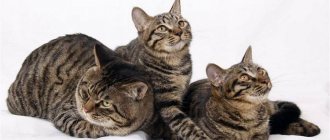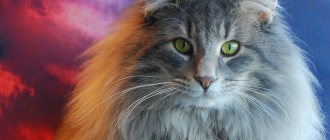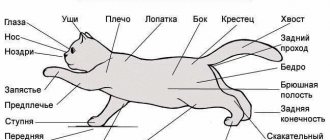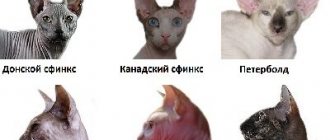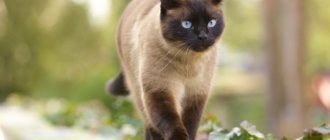History of the breed
Russian Blue is one of the oldest domestic breeds. The first mention of it dates back to 1860. The beautiful appearance and character of Russian blue cats largely determined their popularity. By the way, at first the breed was loved in England. There are many legends regarding the history of its origin. Perhaps British sailors from Arkhangelsk brought these cute creatures to their homeland. The beauties with gray-blue fur captured the hearts of the British. A little later, Catherine II presented a blue cat to the English queen herself as a gift. In Russia and Britain, because of their special appearance and character, Russian blue cats were called real lords of magic and magic.
This breed is one of the Russian aboriginal varieties. There have been numerous debates regarding the history of the origin of the species for a long time. They say that very similar creatures were found not only in Great Britain, but also in Spain and the Scandinavian countries. Of course, British breeders made their contribution to the development of the standard. However, cats have never lived in the wild in Britain. There is evidence confirming the residence of blue Russian cats in Scandinavia, which speaks in favor of the theory of the origin of the breed in the northern part of Russia.
In the sixteenth century, it was not for nothing that sailors took a liking to beautiful animals. Due to their character, Russian blue cats showed courage and actively caught mice. Representatives of royal families valued animals incredibly highly because of their beautiful eyes and extraordinary fur. Such pets lived in the family of Nicholas II, Queen Victoria. In Russia there is even a belief that the animal protects its owners from evil spirits. Therefore, in the old days, cats even guarded the sleep of babies.
Character and intelligence
The gentle nature of Russian Blue cats has become one of the reasons for the popularity of animals. These cute creatures are incredibly tactful and obedient. But, on the other hand, smart animals love to demonstrate their character. Russian Blue cats, although meek and delicate, have their own opinions. At the same time, when communicating with their families, they show the best qualities. The animal feels the tone and voice of the owner, even reacts to gestures. A very important character quality of the Russian Blue cat, described in the article, is the absence of sabotage and vindictiveness. The animal can happily sit with you by the TV or fireplace, but at the same time does not allow itself to be squeezed.
But in relationships with strangers, cats behave very warily. The cute creature will show coldness until it gains confidence in its new friend.
Pros and cons of Russian Blue cats
Owners who own Russian Blue cats have mixed opinions about the peculiarities of keeping such pets.
Among the most frequently noted advantages are:
- Increased cleanliness. Cats only shit in the right place, disdain to use a dirty litter box and perfectly lick their fur on their own;
- Extraordinary intelligence. Due to their tendency to learn, representatives of the Russian Blue breed are highly trainable and are able to learn several commands. The main thing is patience and affection on the part of the owner. These pets do not tolerate bullying and violent treatment;
- Shyness. Owners of Russian Blue cats rarely hear loud meowing from them. The pet's voice does not rise even during hormonal surges. Such animals are perfect for lovers of peace and tranquility;
- Independence. Representatives of this breed can be safely left alone for the whole day. They steadfastly withstand the absence of their owners, quietly awaiting their return;
- Obedience. Cats are not at all vindictive and unforgiving. They will not deliberately climb on tables or shit in inappropriate places because of the owner’s scream.
Such pets get along well both in large families and with those who love solitude. The main thing for them is sufficient affection, care and always fresh litter in the tray.
As for the disadvantages of these animals, they include:
- Attachment to the place of residence (moving can provoke depression and negative mood in the animal);
- Timidity (cats treat guests with extreme caution, preferring to hide from them behind furniture);
- Tendency to hunt (if a parrot inadvertently flew out of its cage, it will obviously have a hard time).
In general, Russian blue cats do not pose any particular inconvenience to their owners. They are very affectionate, love to sleep in the same bed with their owner and lull him to sleep with quiet and pleasant purring.
How does socialization work?
The description of the character and breed of the Russian Blue cat gives grounds to assert that the animal is suitable for living in absolutely any family, including a very large one. Often these pets are owned by older people. This is due to the fact that cats are able to be attentive and listen to their owners. In addition, they perfectly calm people down during periods of depression. An important character trait of the Russian Blue cat (photo given in the article) is its amazing attitude towards children. When it comes to communicating with kids, animals quickly forget about their arrogance and aristocracy.
They happily take part in all children's fun. By the way, cats never use their claws when communicating with people, even if they are dissatisfied with something. The only creatures with which conflicts can arise are dogs. But this story is as old as time and is a classic.
Appearance
The Russian Blue cat is considered a medium-sized animal, with a body weight of around 5 kg. This elegant and fit animal has a coat similar to that of British cats, while the rather thick coat visually makes the animal’s neck shorter.
We can assume that the tail is not long, and the limbs are elongated, with the hind limbs being somewhat longer than the front ones. The paws are oval shaped. The ears are quite large, the nose is straight, and the head is wedge-shaped. The whisker pads are very noticeable.
The Russian Blue's eyes are almond-shaped, widely spaced, and green in color, which gives these cats a special charm. It should be noted that the color of the iris of the eyes can have different shades of green.
Interesting to know! Kittens that are born have blue eyes, but after a long time, as they grow and develop, which can take years, the eye color will turn green.
The characteristic appearance of the Russian Blue cat is due to its dense double fur, which has a silver shimmer. An important fact to note is that the length of the coat and undercoat are almost the same. The metallic sheen is formed due to the bleached ends of the guard hairs.
If the animal is characterized as stocky, with a pronounced oriental type, as well as the presence of a round or quadrangular head, close-fitting fur, large-shaped eyes, a relatively wide tail at the base, the presence of yellow inclusions in the main color, as well as the presence of white stripes color and spots on the coat, then this can be safely attributed to breed defects.
Animal training
Positive reviews about the character of Russian Blue cats for many people are the best characteristics for an animal. The breed's character traits have been developed over many years. Therefore, such pets do not need training. In addition, attempts to influence character change can lead to psychological trauma. As a result, the cat can turn into a resigned creature like a robot. It is worth remembering that raising an animal should be carried out in a calm and quiet tone.
This is quite enough for a sensitive and intelligent creature. While still kittens, animals very quickly get used to using scratching posts and trays.
Diet of Russian Blue cats
In order not to jeopardize your cat's health and maintain its vigorous state, it is necessary to follow some feeding recommendations. Small animals should be fed with milk until the first month, gradually introducing cottage cheese and cheese into the diet. Feeding food during this period is prohibited - flavorings and artificial additives can negatively affect the health of the pet. From a month on, you can introduce boiled yolk and lean meat into complementary foods: rabbit, chicken, beef.
Transferring an animal to dry food is possible only after it reaches the age of 2 months. The transition to artificial feeding occurs gradually. For a smoother switching of the body, it is recommended to pre-wet the dry granules in water. Unlike other purebred cats, Russian Blues can eat both natural and artificial food at the same time.
The main thing is to follow certain rules:
- Do not give the animal the remains of your own food (they may contain trace elements that are prohibited for animals of this breed);
- After each meal, wash the bowl (Russian Blues are very picky about cleanliness of dishes);
- Check the availability of water regularly (there should always be clean and fresh water in the animal’s bowl);
- Follow the rules of a complete diet (pets' food should include equal amounts of fats, amino acids and taurine);
- Buy medium and premium food (budget mixtures are less healthy and animals don’t like them as much).
The ideal diet ratio for Russian Blue cats is 70% dry food and 30% wet food (canned food, meat, preserves) or natural products (boiled meat, eggs, dairy products). It is also recommended to introduce vegetables rich in beneficial vitamins into the feeding. This is especially true for carrots - if your cat eats them, then periodically add them to the food mixtures (in ready-made form).
Proper nutrition is the key to an animal’s well-being, the beauty of its coat and longevity. That is why it is not recommended to neglect the above rules. If possible, consult a veterinarian who (based on tests) will be able to select the most suitable nutrition option.
Animal activity
For the most part, due to their character, blue Russian cats, described in the article, are incredibly playful and active. If you want to get such a cute pet, then prepare in advance for the fact that you will need to purchase a special ladder and a house with an elevation. The breed has strong hunting instincts, which affects their games. Animals catch flies and can also chase tiny specks of dust in the air.
Russian Blue cats are the best jumpers among the known breeds. Pets can easily jump onto the cabinet without running. Animals often prefer to make their homes on mezzanines, dragging all their toys there.
Popular colors of Russian blue cats
The main color of cats of this breed follows from their name - blue. Moreover, any spots, transitions and lightening/darkening are a sign of the introduction of other breeds into the pedigree, which is strictly prohibited in accordance with phenological standards. The only acceptable deviation from the norm may be barely noticeable stripes on the kittens’ bodies. However, even such spots in true representatives of their kind disappear over time.
The key features of the classic color are:
- Color density (achieved due to the thickness of the wool);
- Uniformity (the shade is the same in all parts of the animal’s body);
- Shimmer (the fur of purebred blue Russian cats shimmers with light tints).
Light lightening is permissible only in the area of the nose and ears, where the animal’s skin is visible due to the reduced thickness of the coat.
Until recently, Russian cats were really represented in the world in only one color - blue (i.e. gray with iridescence). However, in the second half of the last century, due to attempts to increase the population of this breed, two more varieties were bred.
This:
- Russian Black (Russian black) - Great Britain 1960;
- Russian White (Russian white) – Australia 1970.
Both types of animals represent deviations from the norm. They are also characterized by an exclusively solid shade without the presence of spots, stripes, or transitions. Such breeds are not recognized everywhere. They are allowed only in the phenological associations of Africa, Australia and Great Britain. At the same time, the white and black subspecies belong to the same group “Russian cats”. In other countries, these two peoples are not recognized.
Pet care
Caring for pets of this breed is not difficult. In general, it is the same as caring for any short-haired representatives. The animals themselves are very clean. They do not shed profusely, but monitor the length of their claws on their own. What owners should remember is the mandatory water procedures and careful ear care. Pets need to be bathed approximately once every six months. But the ears need to be wiped with cotton swabs or a soft cloth with liquid, which can be purchased at any pet store.
Long-haired representatives
It is worth knowing that there are also long-haired representatives of the Russian Blue breed. Nibelungs were bred in the late eighties by the Americans. And in the nineties, the breed was officially recognized throughout the world. The character of the Russian Blue Longhair cat is not too different from other breeds. Such animals also adore their owners, they are calm and balanced.
But care for long hair is more thorough. It must be combed regularly with a metal brush. In order to preserve the color of animals, they should not be allowed to remain in the sun for a long time, otherwise the fur may get a rusty tint. Very often, owners give their pets mineral supplements. However, it is worth remembering that you should avoid preparations with seaweed and iodine.
Conditions for pets
Animals love all kinds of heights. In general, you should take care to create your pet’s personal space. The ideal option is a house with a roof on a hill. Cats feel completely uncomfortable if they fall asleep in an open space. You should forget about rugs and baskets. In addition, your pet will need a metal bowl, which should be very stable. It is preferable to place the tray far from the resting place, for example, in the bathroom or in the toilet.
What to feed cats?
If you prefer natural feeding, your pet should receive a dairy and meat dish at one meal. Meat products can be represented by chicken or lean beef. As dairy food, you can give low-fat sour cream, kefir, cheese, cottage cheese, kefir or natural yogurt. But fatty fish and whole milk should not be given to animals.
Experienced experts recommend using high quality feed. Thanks to them, it is very easy to preserve the beauty of wool.
Reproduction
Puberty of Russian Blues occurs quite quickly. After which the animals melodiously purr remind you of natural instincts. This is how cats call cats, and vice versa. Males are very gallant gentlemen. They can groom a cat for several days to get her to like her. Since the breed is not artificially bred, pregnancy and childbirth occur without complications in animals. As a rule, 4-5 kittens appear in one litter. Russian Blues are the best mothers in the world. They take very good care of their children.
Kittens
Russian Blue kittens have developed hunting instincts from an early age. They rush to catch everything they see. Big dreamers and inquisitive creatures choose a variety of active games. Of course, as animals grow older they become much calmer. Pets' favorite pastime is to freeze, like a porcelain figurine in the most visible place. The animals do this quite consciously so that everyone can admire their grace and beauty. Cats tolerate loneliness well, but they love to communicate with their owners. And he will certainly respond to caresses with a gentle purr. In kittens, the establishment of coat and eye color lasts up to two years. They are sociable and adapt incredibly quickly to new living conditions. Therefore, when you bring a baby into your home, you don’t have to be afraid that he will be too sad. Within a few days, the animal will become so attached to you that in the future it will follow you around.
The animals get along well with other pets. But small animals in your home can become prey for an animal with pronounced hunting instincts. Moreover, this has nothing to do with the cats’ diet. It’s just how nature intended it to be. Therefore, hamsters and parrots will always be in danger. But such hunting abilities will certainly come in handy if a mouse appears in the house. The Russian Blue will deal with uninvited guests very quickly. By the way, animals love praise.
Content Features
This cat breed is characterized by good health, but despite this they are still prone to some diseases. To avoid problems, it is important to keep your pet in suitable conditions. Closed spaces are not to the liking of four-legged animals, and therefore it is not recommended to leave the cat in the room and close the door so that it cannot leave the room.
Play complexes are bought in specialized stores or made with your own hands. Such a place should be equipped with an entertainment area and a recreation area. It is recommended to have a house where the cat can hide from the annoying attention of children or guests. Animals by nature are adapted for climbing at different heights, and therefore if in such a complex there are different ladders and planks, then this will greatly diversify the four-legged leisure time. Also, there must be a scratching post in the house.
Instead of an afterword
Funny and smart animals are wonderful and loyal friends. The breed has so many advantages that it is suitable for absolutely all families. They are great with children and never show aggression. And kindness and loyalty are the main qualities for a pet. Russian Blues treat their family with tenderness. They will never refuse the opportunity to sleep in the arms of their owners, curled up into a ball, which causes tenderness and delight in people.
Thanks to the cleanliness of the animal, even allergy sufferers can get representatives of the breed. And the love of cats for children and the desire to participate in all games with children make it possible to take such a pet into families with children.
Diseases and health problems
To date, no diseases have been identified that are unique to representatives of the Russian Blue breed. However, there are several diseases to which these cats are very prone. Almost all of them are related to living in an apartment (lack of activity and fresh air) and poor diet.
The most common health problems in Russian Blues are:
- Diseases of the musculoskeletal system. Representatives of the Russian Blue breed are prone to arthrosis, arthritis and osteodystrophy. Diseases can occur against the background of metabolic disorders and a lack of vitamin D in the body. Such problems are expressed by increased bone fragility;
- Skin diseases. The most common cause of skin diseases is an allergic reaction. Symptoms of such disorders are expressed in increased itching in the abdomen, paws, and head;
- Kidney diseases. Kidney diseases develop in cats that are already in old age. Such disorders are especially common in inactive pets prone to obesity. The most common diseases are: amyloidosis, hydronephrosis, glomerulonephritis;
- Heart diseases. The functioning of the cardiovascular system is observed in a small number of representatives of the breed. Most often, diseases are congenital or caused by infections;
- Infectious diseases. Viral diseases can be presented in the form of plague, rabies, panleukopenia, coronavirus, anemia.
In addition, Russian Blue cats often suffer from eyes, ears and teeth. All diseases of this nature manifest themselves externally. That is why you should conduct an independent examination of your pet daily (or at least once a week).
Important fact: Signs of deterioration in the animal’s condition may include: lack of appetite, increased drowsiness, decreased activity, vomiting, diarrhea, changes in coat structure. If they appear, you should go to the veterinarian as soon as possible. Only well-chosen therapy can completely eradicate a specific disease.
